Flowering Vines That Will Thrive in South Carolina
South Carolina is home to an incredible variety of landscapes, weather patterns, and soil profiles: from the cool, rocky mountainous topography of the northwest, to the breezy, warm Atlantic coastal plain, and everything in-between. There is a rich variety of native and naturalized flowering vines gardeners can choose from to adorn their gardens. Some of these may already be lurking in a gardener’s backyard, yet others may have been spotted while hiking through the beautiful parks that South Carolina has to offer. Each of these plants have a unique role to fill on the right gardener’s property.
Carolina or Yellow Jessamine (Gelsemium sempervirens)

Starting with the stunning official flower of South Carolina, Carolina (yellow) jessamine is a gorgeous climbing vine that can add both significant bulk and fragrant, sunny-yellow dainty blossoms to a sturdy arbor or trellis. Yellow jessamine is one of the first vines to bloom of the year, frequently starting during the first warm days of late winter. The first flush of blooms is the largest, but it will bloom occasionally throughout the summer with smaller flushes in early fall, when the first cool nights arrive. The early blooming period makes this plant a very important source of nectar for hummingbirds, butterflies, and bees, helping them to survive the last difficult weeks of winter and early spring. This 10-20′ vine is largely evergreen, even through some of the frigid ice storms that may occur during winter. With this evergreen trait, yellow jessamine is a fine specimen to use as a part of a garden privacy project for walls, windows, sitting areas, pools, or fencing; the intoxicating, divine fragrance will delight those that you choose to entertain in its presence.
This plant does produce berries, and it is important to note that the plant in its entirety is toxic for both humans and pets. Please exercise caution when used in a landscape used by children, pets, or livestock.
Atlantic Pigeonwings (Clitroia mariana)
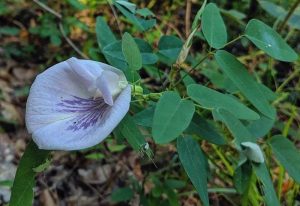
Reaching a meager height of up to 24″, Atlantic pigeonwings are an easily managed, delicate variety that is ideal for small gardening spaces, container gardens, or for forefront plantings in beds. The small stature of Clitroia mariana may fool the unsuspecting gardener; also known as the butterfly pea, the exotic, elegant purple flowers it produces on its small stems are absolutely stunning. It’s a whimsical woodland treasure that deserves a spot in the average South Carolina garden.
Since it is a woodland plant, it is tolerant to partial shade and greatly enjoys being planted close to larger plants and trees. Well-draining, sandy soil is preferred by Atlantic pigeonwings; sandier soils in the eastern part of the state will provide an excellent growing medium for this species.
Climbing Aster (Ampelaster carolinianus)
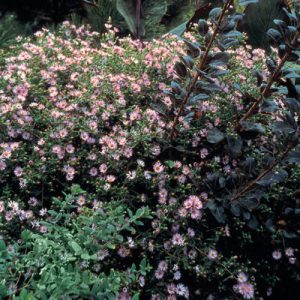
An important larval host plant of the Pearl Crescent Butterfly, the climbing aster is another beneficial plant for a South Carolina gardener’s backyard. This sprawling behemoth daisy-like plant will go beyond 10′ in any direction; it will climb, crawl, and overtake anything that it is allowed to. It will reward its keeper with a profuse, extravagant display of pink-purple flowers with fine, whispy petals.
Owners may find that this overzealous plant requires pruning (and division) during the early spring, but this tends to be common among vining plants. Powdery mildew and “wet feet” can be problematic, especially during humid, wet summers. If planted outside of a low-lying area with full sun to partial shade, it’s a relatively easy keeper.
Climbing Hempvine (Mikania scandens)
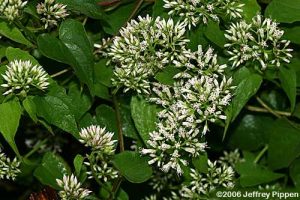
For gardeners who have a low-lying area that is prone to flooding, runoff, or frequent high soil moisture (near hoses or livestock troughs for example), the climbing hempvine is a wonderful option. Wet soil can be difficult to plant in, as most plants don’t like wet feet. In the wild, this plant is only located in floodplains, near lakes or ponds, or in the coastal plain. It prefers a forested or shrubby habitat, so it is tolerant of partial shade. Growing up to 10′ long, it will form a dense mat in an open environment. When surrounded by other plants or trellising, it will climb happily.
Climbing hempvine is a wonderful choice for gardeners looking to establish a butterfly garden, and it attracts many other beneficial insects including bees, beetles, and spiders. During the long blooming season, great clusters of delicate white-pink flowers adorn the foliage, leading to an incredible, bustling display of butterflies and bees.
Trumpet Vine (Campsis radicans)
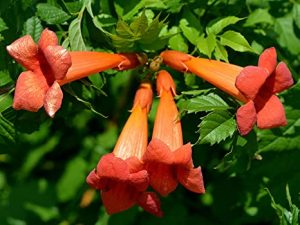
Living in the southeastern United States, most gardeners have likely seen the trumpet vine, or hummingbird vine, in full bloom with its vibrant orange, trumpet-shaped flowers during the muggy summer months. The trumpet vine is an incredibly common and highly prolific deciduous woody vine, growing beyond 30′ if given the chance. It is reputed to be an invasive plant but is in fact native to the southeastern US (and South Carolina.) This opportunistic vine is a perfect beginner friendly species, with the added benefit of being an attractive butterfly garden and hummingbird garden choice. It thrives in dense clay soils and at the edge of woodland environments (where it has access to lots of sun and branches to climb.) In an open garden setting, lots of trellising will keep the hummingbird vine very happy.
Since the hummingbird vine is quick to take over, heavy pruning is highly recommended to keep other plants healthy; it is important to wear gloves when handling this beautiful plant if one has sensitive skin, as it could potentially cause contact dermatitis.
Dutchman’s Pipe (Aristolochia macrophylla)
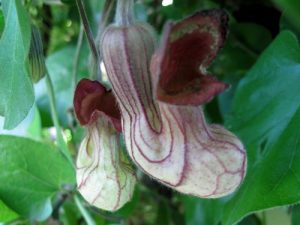
Dutchman’s pipe is likely the most unique, curious plant included on this list of flowering vines. One may be fooled into thinking this is a tropical plant, due to the beautiful, exotic flowers it produces when in bloom. This perennial is native to the eastern United States and is an important host for the native Pipevine Swallowtail Butterfly caterpillar. It is named for its striking flowers, as they resemble a Dutch pipe which is used for smoking tobacco.
The native range for Dutchman’s pipe is largely within mountainous or hilly terrain, where wooded slopes or ravines may be found. It greatly prefers moist soils and would do well in partial shade in a low-lying area.
Virgin’s Bower (Clematis virginiana)
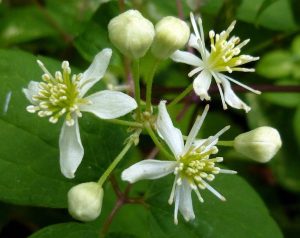
For a plant that will offer winter charm in the garden, virgin’s bower may be of interest. It produces intriguing whimsical seedheads unlike most other ornamental plants, giving the garden something to display during the long winter days. This is only the icing on the cake for this particular plant, though; the flowers that produce those seedheads are intensely fragrant and prolific, putting on a stunning, intoxicating display during the growing season. If that wasn’t enough, the blooming period is incredibly long- a couple of months long, in fact. Unfortunately, the plant is toxic to humans, pets, and livestock, so caution must be used when planning the transplant location.
Virgin’s bower is unusually tolerant of shade, being from the clematis family, and greatly enjoys wet soil. It performs best growing up to 20′ in length when the vines and leaves have access to full sunlight, with the root system being shaded. Companion planting with other shorter plants can help virgin’s bower to thrive.
Wild Potato Vine (Ipomoea pandurata)
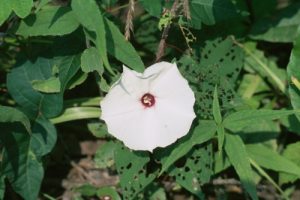
Commonly confused with invasive bindweed and morning glories, the wild potato vine is actually a noninvasive native plant. This perennial flowering vine produces beautiful, large saucer-shaped white flowers with a striking pink-purple throat; this makes it easy to confuse with both invasive species mentioned. It greatly enjoys being planted at the edge of woodlands or among plentiful trellising, but it isn’t picky. It will grow virtually anywhere, especially where soil is disturbed.
Reaching over 30′, this plant is absolutely massive. It is a vital part of its local ecosystem as it provides nectar for various butterflies and bees. The foliage and tubers are feasted upon by various insects, as well. Tubers are reported to be edible for humans especially when harvested small; larger tubers are bitter and can reach a whopping 22 pounds in size.
American Groundnut (Apios americana)
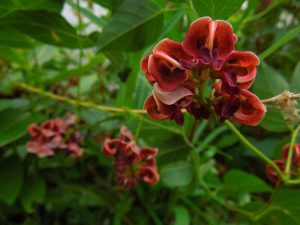
The American Groundnut is a particularly exciting choice for gardeners who want a dual-purpose edible and ornamental flowering vine. This native perennial legume reaches over 16′ in length and produces stunning blooms during the summer, which resemble wisteria, peas, or beans. Not only is it a stunning flowering vine that puts on a beautiful show, but it is edible in two different ways. Once the vines have flowered, edible pods develop. Towards the end of the growing season, gardeners can harvest the prized part of the American groundnut: its edible tubers. This plant has a long history of use as a food plant by Native Americans, but it isn’t a popular choice for commercial production currently. Instead, it is being discovered and utilized by home gardeners as a dual-purpose plant in the home garden. Humans are not the only ones who benefit from this incredible plant, though; small mammals, birds, and pollinators use it as a source of food, with one of its most popular visitors being leaf cutting bees.
The American groundnut enjoys moist to wet soil, commonly growing in wet areas of its native zone such as flood plains, alongside creek beds, or along riverbanks. Full sun is best for productivity; it can grow in partial sun, but it may not produce as many leaves, flowers, pods, or tubers. Foliage will die back during the winter months making cleanup and pruning a breeze. Simply wait to clean the garden until late winter, and the brittle waste that remains will trim and pull away with ease.
Passionflower Vine (Passiflora incarnata)
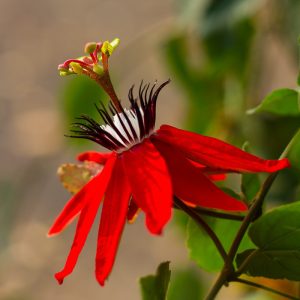
Another native dual-purpose flowering vine that was commonly used as a source of food is the passionflower vine, or maypop. This stunning flower is very exotic, producing mesmerizing, large purple flowers that are incredibly complex and intricate. Flowers and leaves have a reputation within herbal medicine, adding yet another use for this flowering vine in the South Carolina home garden. As the vine runs along the ground, the flowers fade and small fruits form, in an indeterminate nature. The maypop vines tend to creep and spread along the ground without issue; however, a trellis is preferred for putting their beautiful flowers on display at eye level. The trellis used must be capable of supporting the extensive vines and their fruits, as the vines can be quite prolific.
The passionflower vine is an opportunist and is quick to grow in open fields. Since it is a food source for wildlife, numbers of volunteers may increase year after year as the wildlife spread seeds through feeding. It does very well in full sun with adequate drainage and grows happily in clay soils. It is a beginner gardener’s dream, as it has so much to offer without being fussy to care for.
What Should a South Carolina Gardener Do to Prepare for Growing Flowering Vines?
Growing flowering vines requires a lot of space, with very few exceptions (such as the Atlantic pigeonwings.) Flowering vines commonly reach up to 30′ in length, which means trellising is vital for the success of the plant. Pruning and shaping is very common among most perennial vines, with the most vigorous ones needing pruned multiple times per growing season.
For plants grown in close quarters or containers, frequent fertilization may be required to maintain the plants, especially for vigorous vines. This is also true of watering; during the height of summer, very large plants can dry out and wilt very easily, especially if they are growing in full sun. Containers may require water twice per day.
Many of the flowering vines on this list are quite easily to care for, especially since they are native to South Carolina. Therefore, many will thrive regardless of the gardener’s input, if they are planted in an appropriate location. Native plants are some of the best plants for a budding gardener to start with, and they offer so many benefits for the local wildlife, pollinators, and even for the humans that choose to grow them.
